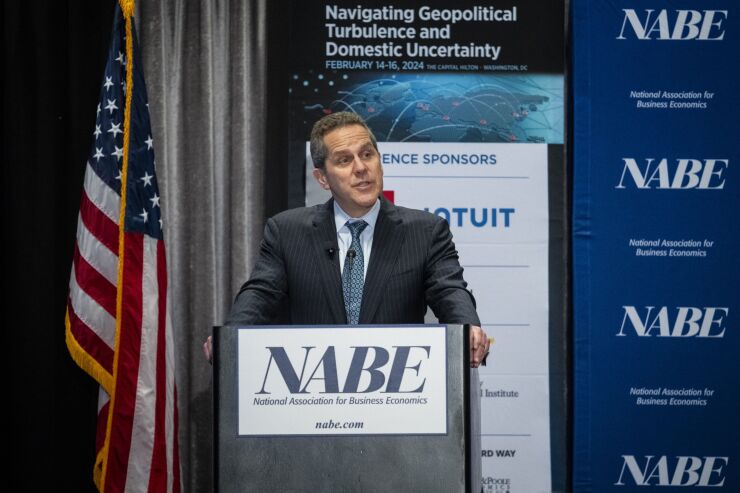
WASHINGTON — Federal Reserve Vice Chair for Supervision Michael Barr said Wednesday that recent turmoil in the regional banking sector is not indicative of problems in the broader banking system, but noted that banks should prime themselves to tap the Fed's discount window and that the central bank is working to improve its operations at the last-resort lending facility.
In a speech before the National Association of Business Economists annual conference, Barr said the recent declines in stock valuations at a number of regional banks that kicked off after a Jan. 31 earnings call from New York Community Bank — in which the bank reported a quarterly loss due to increased regulatory compliance costs and additional loan loss reserves — is not cause for concern. Without naming New York Community Bank explicitly, Barr said a single bad result at a single bank should not be interpreted as a leading indicator of future turmoil.
"A single bank missing its revenue expectations and increasing its provisioning does not change the fact that the overall banking system is strong," he said. "We see no signs of liquidity problems across the system."
But Barr reiterated his call for banks to preposition collateral with the Fed's discount window to give it more liquidity options in times of stress, and said the Fed is also working on its end to make the process smoother and more routine.
"Banks should do some preparation to be fully ready to tap the window [and] that includes pre-positioning collateral, and testing discount window usage," he said. "While banks do their part to get operationally ready, we at the Federal Reserve also need to continue to improve discount window operations."
Barr has
Barr also noted that despite what he characterized as the banking system's continued resilience and recovery from last spring's turmoil, regulators remain vigilant in monitoring certain pockets of risks. He also discussed the rising risks related to commercial real estate lending, which he said continues to pose challenges for banks due to decreased revenues and valuation of properties after the pandemic triggered the rise of remote work and office space reductions.
Federal regulators like Treasury Secretary Janet Yellen have
Barr similarly said Wednesday that the banking system is in "much better shape than it was last spring," even despite "a few pockets of risk that we continue to watch, including the pandemic's persistent impact on office commercial real estate in certain central business districts.
Reflecting on last year's failures of Silicon Valley Bank, Signature Bank, and First Republic, Barr said the runs at these firms were particularly severe due to their unsafe reliance on uninsured deposits from concentrated and highly interconnected customer bases.
Because deposits at these three firms were more volatile than previously anticipated, Barr noted the firms faced challenges in meeting outflows with available assets, particularly with securities designated as held-to-maturity. That's because, according to Barr, as interest rates increase and the value of HTM securities decreases, firms that account for HTM securities at amortized cost do not have to reflect this decline in value on their balance sheets.
"But selling even a portion of an HTM portfolio results in a firm needing to recognize losses on the entire portfolio — a hit to capital," he noted. "The ability to turn HTM assets into cash, particularly when sales are not feasible, is limited by a firm's ability to ramp up access to secured funding sources, which proved problematic in large size last March."
Barr expressed satisfaction that banks have been tackling these risks by decreasing reliance on held-to-maturity assets for liquidity, adjusting portfolio compositions, improving access to diverse liquidity sources, and revising contingency funding plans.
"These improved practices are important for both ensuring individual firm resilience and aggregate financial stability," said Barr.
Barr noted that last year's banking crisis seems to have led banks to prefer holding more reserves at the central bank than they had prior to the Covid pandemic, and that this preference could eventually be at odds with the Fed's ongoing policy of balance sheet reduction. But the Fed's establishment of a standing repo facility after
"It may be difficult to determine what level of reserves is consistent with 'ample,'" Barr said. "The market dynamics from September 2019 illustrate this. This episode was a factor leading to the establishment of the standing repo facility, which, along with the discount window, will help dampen pressures that could emerge in short-term money markets."






